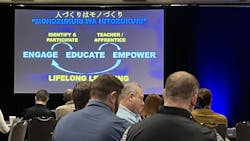The 3 E's of TPS and How the Basics Never Go Out of Style
The Toyota Production System is not a wishy-washy construct. It’s built on core principles that guide how the manufacturer builds product, grows people and improves operations. Among the continuous-improvement crowd, many of its tenets are embraced, built upon and launch endless discussions on the topic of manufacturing excellence.
Brett Wood, president and CEO of Toyota Material Handling North America, recently spoke about the Toyota Production System during a keynote address at the IndustryWeek Operations Leadership Summit, held recently in Indianapolis.
“I'm not going to teach you TPS. Probably some of you know it even better than I do, which is great,” he said. Instead, the keynoter addressed several of the operating system’s key principles, “and just maybe it gives you a few reminders about what’s involved in the process of building things, making things and maybe [you] take home a couple of new ideas.” (Read more about Brett Wood’s keynote address in What Toyota Looks for in Future Leaders.)
Here is a review of several TPS principles Wood touched upon.
Engage, Educate, Empower
“We like to really focus on people a lot, and there's a couple of things we say, the three E's: engage, educate, empower,” Wood said.
Engage: “[It’s] not just saying, Okay, here's your job and good luck. [It’s] engage with them every day. Talk to them about their process, how it could be better.”
Educate: “Give them a mentor to help them. That's right from day one.” That person they can look up to and learn a lot from.
Empower: Wood mentioned empowering employees to stop the production line. “We don't have five quality inspectors. We have 500 quality inspectors, and people can actually just stop the line and say, ‘Hey, what just happened … doesn't look right so we need to make a change and then make an improvement.’”
Kaizen: “We like to encourage small ideas,” Wood said. “I like to say every once in a while, when I give some speeches to our team, ‘You know, a small hinge can swing a big door.’ … I hate it when people feel like they’ve got to hit that home run and come up with a million-dollar idea. That is really not the case.”
5 Whys: “To get to the root cause of a problem, we like to ask why, at least five times: Why? Why? Why? Why? Why? And I think it's a wonderful principle. I see it happening all the time, whether we're in the factory environment or even in the office environment, trying to get to the root cause of a problem. It's just so simple. Just keep asking why.”
Involve People in Improvements: “When people don't feel like they're part of the process … they'll find a lot of ways to not look for improvements, but if they really do feel like they're part of the process— they're part of the overall goal—well, you get a lot of energized people.”
Seven Mudas (Waste), or Is It Eight? Wood pointed out the seven frequently cited types of muda, or waste, which are often abbreviated as TIMWOOD. These are the wastes associated with transportation, inventory, motion, waiting, overprocessing, overproduction and defective parts.
"Every day we're always looking to eliminate waste, and that is just a really amazing core principle that, if you can build that into your culture, you've got an army of people every day trying to eliminate waste," Wood noted.
Toyota has added an eighth waste, that of underutilized people, Wood said. That means not using the creative minds of your people to identify where muda exists. “And sometimes I feel like that's probably the worst waste of them all.”
Daily Meetings
Quality Assurance: Each afternoon at Toyota Material Handling’s Columbus site, team leaders and occasionally executive staff, meet to review failed parts that have come back from customers. The questions that are asked: Why did this part fail? How do we keep it from happening again?
“There's not always a quick and easy answer to that, but it gets the awareness out to all the people that are designing and building the truck about customer dissatisfaction,” Wood said.
Kaizen: This meeting is held in what is called the “adrenaline room.” “We do three things in this meeting: What went right yesterday? What went wrong yesterday, and how we can make today better?” Wood said. “So that's the three things we focus on, everything that happened yesterday in that factory that has 2,000 people building a forklift every four minutes.” Every meeting starts with safety, he added.
“By the way, if you want to have a shorter-time meeting, 20-minute meeting, no chairs, right? It's standing room only,” Wood said.
Let’s conclude with what Wood described as one of his favorite TPS principles: Everything has a place. “Finding a tool can be muda. If you can't find the right tool, you just wasted a couple seconds or a couple of minutes trying to find it.”
About the Author
Jill Jusko
Bio: Jill Jusko is executive editor for IndustryWeek. She has been writing about manufacturing operations leadership for more than 20 years. Her coverage spotlights companies that are in pursuit of world-class results in quality, productivity, cost and other benchmarks by implementing the latest continuous improvement and lean/Six-Sigma strategies. Jill also coordinates IndustryWeek’s Best Plants Awards Program, which annually salutes the leading manufacturing facilities in North America.
Have a story idea? Send it to [email protected].

